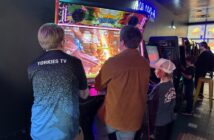The VR Collective Launches at Expo:
The Why Behind the Cool Collaboration Between TrainerTainment, Shaffer Distributing & AVS Companies to Bring VR, Esports & More to Arcades
by Bob Cooney

Bob Cooney
Coin-op distribution has historically been slow to take on new companies and adopt new technology paradigms. In the late’90s, I joined the founding team of a fledgling startup called Global VR. They had a boom-mounted VR arcade platform, the VR Vortek, that solved most of the problems that challenged early virtual reality systems. Though the product was good, it took years to crack the amusement distribution market despite being successful at Dave and Buster’s and dozens of other FECs around the country.
One of the challenges for our industry back then was distribution was a barrier to innovation. Many other companies with good products withered and died because they could not find distribution. It hasn’t gotten much easier.
Since helping Hologate land Creative Works as their distributor in 2017, I’ve received hundreds of calls from companies with VR products asking me for help with distribution. For most of them, I tell them there’s no real solution. They either need to sell direct, or spend years trying to break down the distribution blockade.
It wasn’t until traditional manufacturers like LAI Games, Raw Thrills and SEGA entered the VR fray that full-line distribution got on board. I’ve been helping VRsenal with their distribution strategy since 2019. Despite more than 500 units deployed they still do not have coverage with all the major distributors.
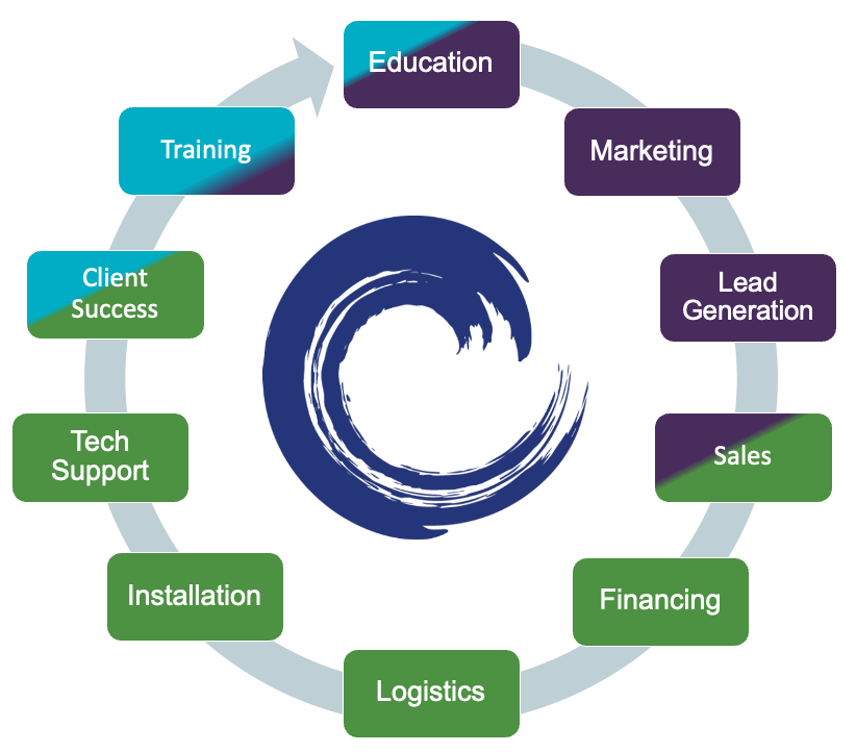
Go-to-market functions for a successful startup.
A Change Is Needed
VR isn’t like most coin-op equipment. It’s expensive, complex and requires a different skillset and approach to sell versus traditional arcade games. I’ve spoken to many distribution salespeople, and privately they confide that selling VR is too hard. They can sell five Big Bass Wheels (Best Game Ever!) with less effort than one VR system. And sales always takes the path of least resistance.
Is that in the best interest of our industry? Silicon Valley knows that startups drive innovation across all sectors. Our barriers to entry only serve to drive smart game developers toward the bigger consumer market where there are clear paths to victory.
It’s time to support the young, innovative companies bringing exciting new products to our market. To do that we need a new distribution model. To successfully launch and scale a product, a supplier needs to support 10 different go-to-market functions.
There’s just no way a startup can do all this without the support of an efficient, well-trained distribution network. Up until now, these functions are cobbled together across a patchwork of hit-and-miss capabilities from disparate companies. If the market is going to continue to grow, we need a unified distribution model that provides all these functions for manufacturers, developers and operators.
Meet the VR Distribution Collective
The VR Collective was announced last month during the Amusement Expo’s VR Summit. The founding members joining me are AVS Companies, Shaffer Distributing and TrainerTainment. The Collective is setting out to streamline the go-to-market for new VR products.
The idea of The Collective had been incubating in my mind for years. It began to solidify when I approached Beth Standlee from Trainer-Tainment. I wanted help creating a training program to increase sales, profits, and customer experience for FECs running attended VR attractions. I was tired of seeing understaffed, poorly run, expensive VR attractions underperforming. Operators were becoming frustrated with VR because they had not been given the tools they needed to be successful. So we started creating the VR Master Training Program.
“VR requires a different level of employee training than arcade games,” commented Candi Kelly, COO of TrainerTainment. More than 75% of Americans have never tried VR at all. The customer experience must take that into account. Yet operators treat VR like any other arcade game. They are leaving so much on the table.”
Around the same time, I pitched the idea of a distribution collective to Scott Shaffer of Shaffer Distributing and Tony Shamma of AVS. I knew they frequently collaborate and were among the most supportive of VRsenal. Shaffer was also representing VEX, a VR company from Belgium I like. They instantly bought into the vision of a new way of doing business.
“We took on the VEX product, and frankly didn’t realize how difficult it would be,” recalls Shaffer. We had to develop new capabilities in our organization. It makes sense to leverage those capabilities for new VR products from other manufacturers.”
“AVS has invested a lot of time, energy, and money building our gaming distribution business in Illinois with IGT,” added Tony Shamma. We know what it takes to bring a new product to market. It takes vision, patience, and persistence. VR is going to be huge for our industry. We are totally committed to building that future.”
Together, we are setting up a new distribution model for the future of immersive entertainment. It starts with VR because that’s the technology we have today. But it won’t stop there. It will soon expand to cutting-edge innovations like augmented and mixed reality, projection mapping, and whatever comes next…like esports.
VR + Esports:
A Recipe for Excitement
Esports is wildly popular. Games like League of Legends and Fortnite pay out millions in prizes each year. They are watched by hundreds of millions of fans, both in stadiums and on streaming platforms like Twitch. Billions of dollars are being invested in esports. Major league sports teams are buying esport teams and building esport arenas. But like the early days of virtual reality, the business models are not quite apparent.
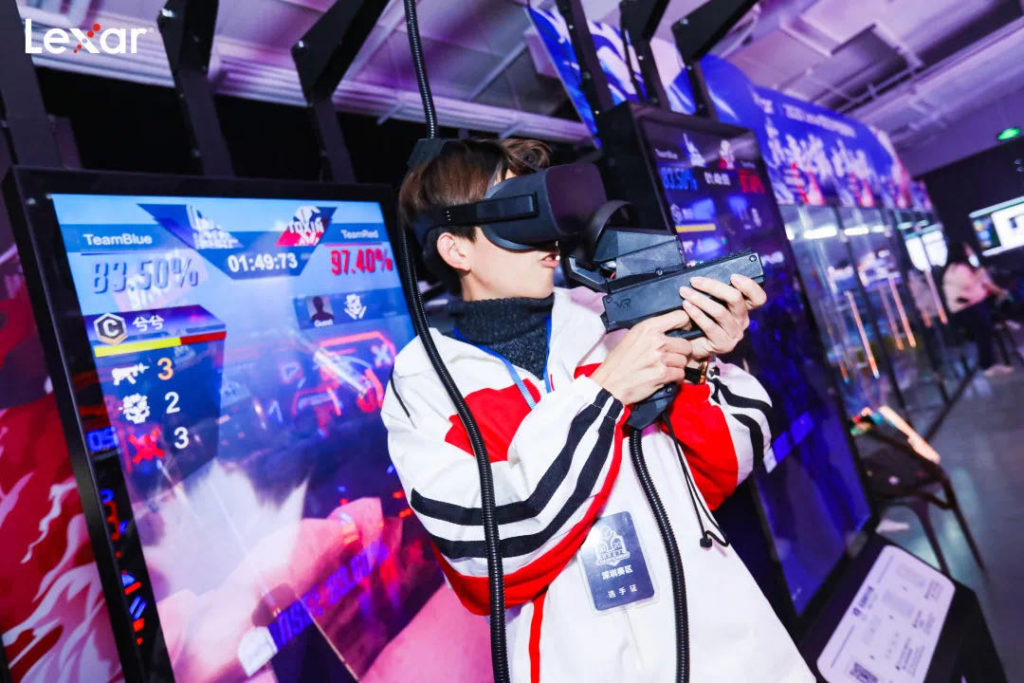
Bob Cooney sees the combination of VR and esports as a true game-changer for the arcade business. Lexar was an event sponsor for the VAR Box Taiwan Championship event, pictured.
Bringing esports to FECs requires a different approach. Renting out computer equipment for games people already play at home is not the recipe for profit. That’s where VR comes in.
Less than 10% of people in America own a VR headset. Yet 90% of those who have tried VR said they want to do it again. This is a blue-ocean market opportunity for our industry. We just need some great games and a new operating model.
While The Collective was developing its business model last year, I was approached by Ben Lee from VAR Live in Hong Kong. Ben told me about their VR esports product running across eight countries in Asia, the birthplace of esports. They had already amassed 2 million plays and 100K registered players.
The promise of creating a new location-based esport, with an unattended virtual reality arcade platform and a global audience, was the perfect launch platform for The VR Collective.
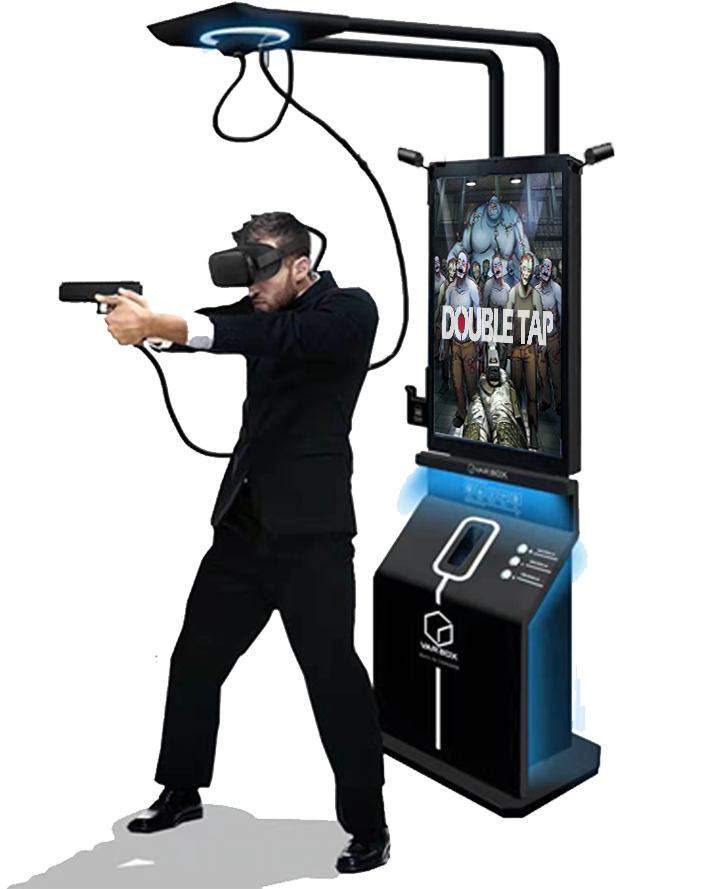
The VAR Box is an unattended VR cabinet with a 42” LCD screen, three different games and nine play modes.
The VAR Box
The VAR Box was unveiled last month at Amusement Expo in Las Vegas. It is an unattended VR arcade cabinet with a 42” LCD screen so spectators can see the action. It has a realistic gun peripheral modeled after a Glock handgun. It’s extremely accurate and has a great haptic kick when you pull the trigger.
It currently has three different games, with a total of nine modes:
Blockade: up to 4 players join forces as waves of zombies attack from all directions. It’s super intense and often has players screaming.
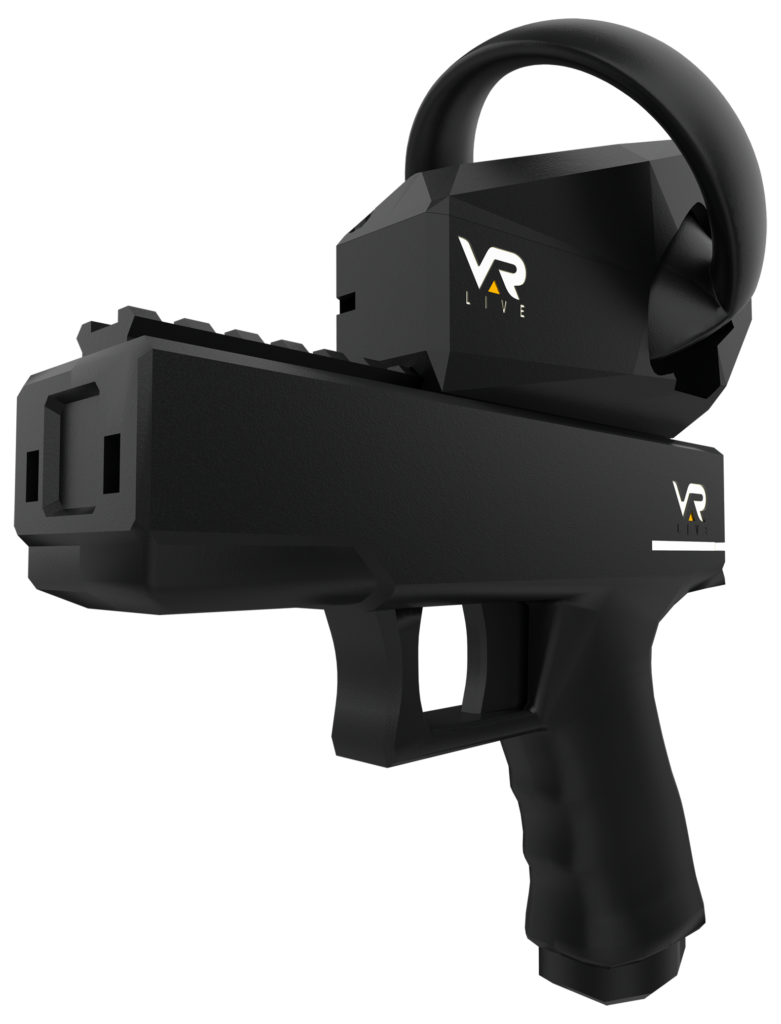
The VAR Box gun is modeled after a Glock, says Cooney, and gives players haptic feedback when they pull the trigger.
Double Tap: a single- or 2-player competitive speed-shooting game. It has six different game modes, including head-to-head competition for tournament play.
Overkill: a 4 vs. 4 squad-based, classic esports first-person shooter. Players can play by themselves with bots, or up to three teammates. They can also play live against players around the world using the global matchmaking system.
There is also a mobile app for players. It has daily missions and challenges with rewards like free games and limited-edition skins. The app lets players track their performance, scores, and leaderboards. After every game, players gather around to see how they performed versus their friends.
The product showed up on the U.S. shores in December. Over the last three months, it’s certainly lived up to its promises. VAR Box uses Oculus Rift, and lists Intel, Lenovo, Digital Domain and other first-tier tech companies as partners. It’s not the typical Chinese VR product.
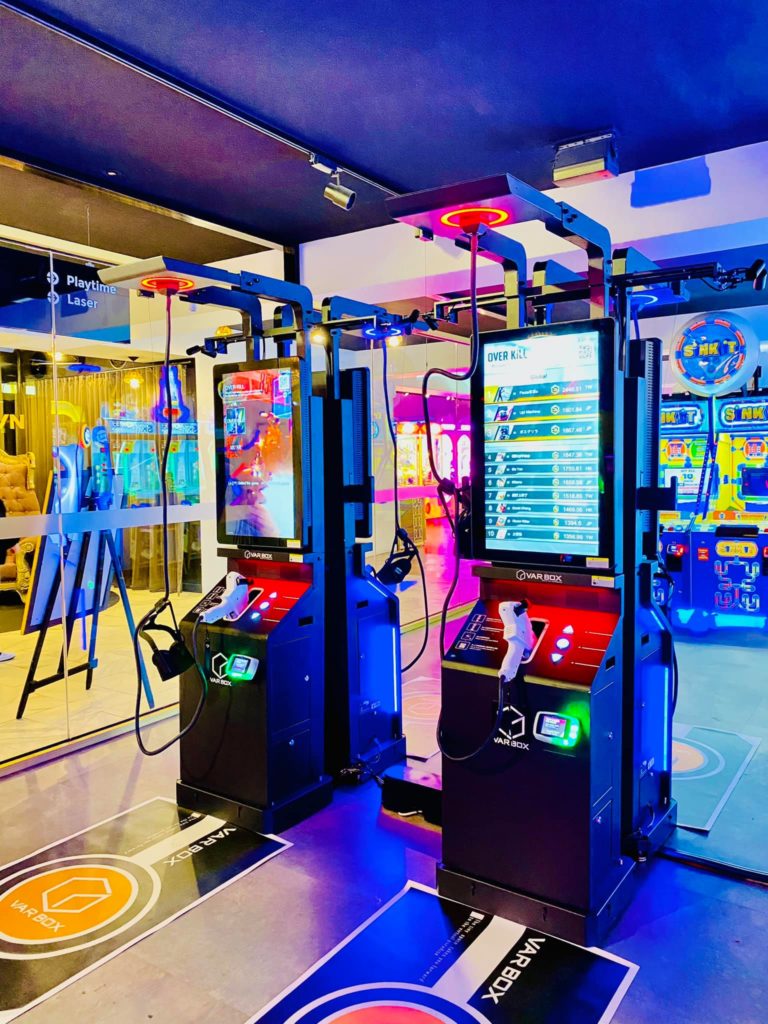
VAR Box on location at Kingpin in Australia.
Alex Teran is the co-founder and operating partner of the Riverside Game Lab in downtown Riverside, Calif. The location is a mashup of a bar, classic arcade and VR center. Alex has nurtured a thriving esports community of fighting-game players and runs up to five fighting game tournaments a week on games like Smash Bros, Marvel v Capcom and Street Fighter.
“If I hadn’t seen the VAR Box perform firsthand, I wouldn’t have believed it,” exclaimed Teran. “It’s as polished as Time Crisis and VR games like Pistol Whip or Arizona Sunshine. I see as many repeats as on Skee-Ball. The player mobile app supports a robust esports ecosystem. I’ve been floored by the success of VAR Box and cannot wait to get more units into the building.”
The VAR Box is also being tested at a Fun Factory arcade in Hawaii. Warren Asing, their EVP of operations, added “Fun Factory FECs are in for a treat with VAR Box. It is robust, built like a tank and resilient. The gameplay is spot-on accurate and worthy of phenomenal repeat play.”
While the VAR Box is performing extremely well as a casual VR arcade game, the promise of building a true, location-based esport is where its real value lies. The VR Collective is looking for early adopters and innovative operators willing to co-create a future where esports is a pillar of the FEC and arcade business. First production units are sold out and scheduled for delivery in May. More will follow monthly.
The initial price for the VAR Box is under $30K per 2-player unit. The Collective esports program is the most robust software, training, and support package ever delivered with an arcade game platform and is priced accordingly. It includes:
• Mobile app with stats, leaderboards, skins, missions and events
• Global, national and statewide tournaments with cash prizes
• Content updates with new games, modes and maps
• Ongoing esports operator training
• Community management training
• Live esports event hosting training
• VIP extended-hour support for live events
The VAR Box represents our industry’s most affordable and scalable shot at staking a claim to the esports market. We started the video game industry, and let it slip away to the consumer electronics companies like Sony and Microsoft. Let’s stake our claim to a share of the esports market before it’s too late.
For more detailed information on The Collective or how to strategically implement VR into your business, contact me at [email protected].
For information on how to sign up for VAR Box, contact Shaffer Distributing at [email protected] or AVS at [email protected].
And if you want to turn your employees into VR Masters, contact Beth Standlee at [email protected].
More information and links can be found at www.thevrcollective.us.
Electronic gaming and location-based entertainment veteran Bob Cooney helps companies with virtual and augmented reality solutions develop strategies to bring their products to the location-based entertainment market. He also helps operators navigate the stormy seas of disruption to select the best virtual reality solutions and experience for their locations. Bob has over 25 years of experience designing, manufacturing and marketing immersive out-of-home entertainment to consumers, operators and venues – first as founder and chief executive of NASDAQ- and Inc. 500-listed Laser Storm, and later as an initial member of the Global VR executive team which introduced the first commercially viable virtual reality arcade game. Cooney went on to become VP of marketing and business development of Ecast, the digital content provider for jukeboxes, and COO of NTN Buzztime, the networked trivia game company. Cooney has been a driving force behind the development of numerous top-earning licensed games, including products based on EA Sports PGA Tour, X-MEN and Stargate, and has been a long-time vocal proponent of leveraging new technology to keep the out-of-home amusement industry-relevant. To get in touch with Bob, visit www.bobcooney.com or email [email protected].


